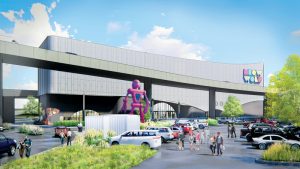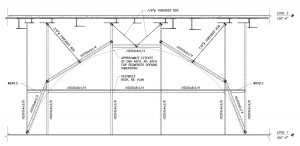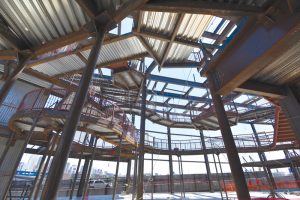Uncertainty and risk are inherent components of any design and construction project. Often, the project team’s management of that uncertainty and how the team behaves during the design and construction process determine the project’s overall outcome. Although this concept may seem obvious to project teams, successfully implementing this integration on complex projects proves challenging. By building trust and setting the stage for an integrated and collaborative team environment, the Meow Wolf project team banded together to mitigate uncertainties and solve the engineering challenges of this distinctive project.
Project Overview
The Meow Wolf Denver structure is five stories of steel framing, plus roof, supported by drilled pier foundations. As a Build-to-Suit (BTS) development, the structure was designed to meet the needs of the tenant, Meow Wolf, a Santa Fe-based arts and entertainment company. Meow Wolf creates immersive, interactive experiences to transport audiences into fantastic realms of story and exploration. This immersive experience for the building design started with the site selection.

One of the primary project constraints is the site’s location underneath a series of elevated roadways. These elevated roadways (Colfax Avenue and Interstate-25) are two major transportation thoroughfares in the heart of downtown Denver. The building’s shape is defined by these curved, elevated roadways that surround it on all sides at the third floor. The exterior skin is inset from the roadways by 10 feet (Figure 1).
The other primary design constraint is that the BTS design needed to allow for a multiphase design process to be erected in a single seamless flow. Meow Wolf’s vision for the experience included catwalks, raised platforms, spiral and rolled stairs, and steel art structures throughout the space. Large column-free spaces were a requirement to accommodate these interior components.
Collaboration with Continuity
A collaborative project mindset is ultimately carried out by the project team members and relies upon external and internal team interactions. Working closely with the designers and sculptors within the Meow Wolf organization, Shears Adkins Rockmore (SA+R) architects led the design team. Turner Construction was engaged as the CM/GC early in conceptual design to provide feedback and constructability input. In addition to external collaboration among various team members, internal collaboration was accomplished within KL&A itself. Unlike a more typical consulting engineering project role, KL&A’s scope for Meow Wolf extended beyond just the engineering portion and included three separate design and construction contracts.
KL&A provided design engineering services for the core and shell (C&S) for the building owner and developer, engineering design for the Tenant Improvements (TI), and finally, engineering services for many of the art exhibits and installations. In addition, given the complexity of the building and the inseparable nature of the final exhibits, KL&A was also selected to provide, as builder, the steel construction on the C&S, TI, and a few of the exhibits. This continuity within KL&A’s team for the overlapping phases of the project allowed for a seamless collaborative design and construction process.
Dual Design Criteria Challenges
The project team was tasked with designing the structure for not only interactive art installations but also to have the capacity to be a storage facility for possible future use. This dual functionality created some unique design criteria challenges, including a large building grid, heavy storage floor loads (250 psf un-reduceable live load), and large floor openings that would need to be infilled for the conversion to occur. In addition, for the initial program, Meow Wolf expressed the need for anchor exhibits within the museum that would stand multiple stories high. This created the need for long-span floor beams and design loads to accommodate structures within the structure. The design loads for the multi-story exhibits and large-scale rockwork theming surpassed the storage load requirements in many cases.
Peter Kelly, P.E. from KL&A, and Project Engineer on the Meow Wolf project, described this explorative design criteria process as a lesson learned. “A big lesson learned for me was that unique challenges are really tough to solve in a vacuum. Often the challenges on this project were so unique that the problems themselves were tough to define. Having the whole design and construction team meeting together with the owner, frequently, to define the ultimate goal of the design and determine the most efficient way to achieve that goal was critical.”
Distinguishable Structural Design Elements
Composite steel construction was chosen to accommodate the need for a versatile structure that can support multiple occupancies, unique geometry, and future retrofit. The heavy column loads resulting from the open building grid and heavy storage loads required concrete drilled pier foundations. The first floor is slab-on-grade over rammed aggregate pier ground improvement, employed due to an abundance of undocumented fill that would otherwise require a costly 15-foot over-excavation. The main wind force resisting system (MWFRS) combines ordinary concentric braced frames and ordinary reinforced concrete shear walls at the stair cores. The stair cores were constructed using the Vulcraft RediCor system to speed construction and eliminate the need for formwork adjacent to the elevated roadways.
Another distinguishable structural design element is the three-story open volumes in the C&S structure that Meow Wolf will use for their most dramatic anchor exhibits. The primary wide-flange columns along the building perimeter in these areas are unbraced from Level 3 to the Roof with horizontal HSS wind girts dividing the span of the cold-formed steel stud exterior wall. Wind columns were added between primary building columns to reduce the horizontal wind girts’ span while also taking some wind load off the primary columns. For the future storage facility design case, the floor openings would be infilled with composite steel construction and wind girts removed, taking the wind load demand off the primary building columns and reducing their unbraced length but adding substantial axial load. The multitude of load cases and boundary conditions that varied between the Meow Wolf and storage facility cases were analyzed and enveloped to arrive at the final design.

One of the most iconic architectural moments as one approaches the building is the elliptical arched entryways carved from the exterior CMU wall. The main lobby entrance is a stunning 50 feet wide x 19 feet tall CMU arch with a glass storefront infill (Figure 2). The length of the surrounding structure on each side of the arch was insufficient to carry reactions associated with masonry arching action, so the design solution needed to bear the weight of the CMU while also bracing the wall and storefront from out of plane loads. HSS wind girts were faceted around the arch in place of expensive rolled structural members, tying into HSS wind columns that aligned with the storefront mullions for concealment. Bent plates with vertical legs of varying lengths were then attached to the HSS girts to reach and support the bottom of CMU. The facets of the steel support system were coordinated with a storefront manufacturer to ensure a tight fit. The finishing touch was a plasma-cut steel fascia covering the head of the storefront to complete the curved aesthetic.

Another structural design consideration that necessitated a high degree of team collaboration was the deflection and vibration performance of the serpentine catwalks. The catwalks and viewing platforms, which are part of the TI design, ramp and weave throughout the three-story open volumes in the C&S structure (Figure 3). The structural design team considered the effects of differential and compound deflections along these catwalks. Some are attached to the building columns, and others hung from the roof above or posted down to a transfer beam below.
The geometry and amount of column transfers complicated the vibration analysis significantly as well. RISA 3D design models of the catwalks were created to run modal analyses and check their natural frequencies in both the vertical and horizontal directions against the recommended design criteria of the American Institute of Steel Construction’s (AISC) Design Guide #11, Vibrations of Steel-Framed Structural Systems Due to Human Activity. As a result, beam sizes were adjusted to meet the vertical criteria. The team found that using the reinforced concrete topping as a diaphragm was the most efficient method of meeting the desired horizontal vibration criteria. At some locations, the curvature of the catwalks was extreme enough to compromise the ability of the catwalks to behave as diaphragms. Consequently, HSS moment frames were added to provide intermediate lateral stiffness.
Community Impact
As the project team itself relied on collaboration among internal and external parties, the Meow Wolf Denver museum also serves as a collaborative mechanism within the local community. Lucian Connole from Meow Wolf commented, “I think Meow Wolf is going to be an exciting, galvanizing part of the Denver community because it invites play and discovery for everyone, as well as being a platform for local artists to showcase their work. In that way, it should create opportunities for dialogue about individual and communal expression.”
Reflecting on the project in its entirety, Evan Forbes, P.E., S.E., Construction Manager for KL&A, concluded, “We learned so much about the critical nature of internal and external collaboration. It was a team effort to not only interpret and protect the vision of these talented artists but also make sure the building is structurally safe, achieves the project goals, and is constructed efficiently.”■
